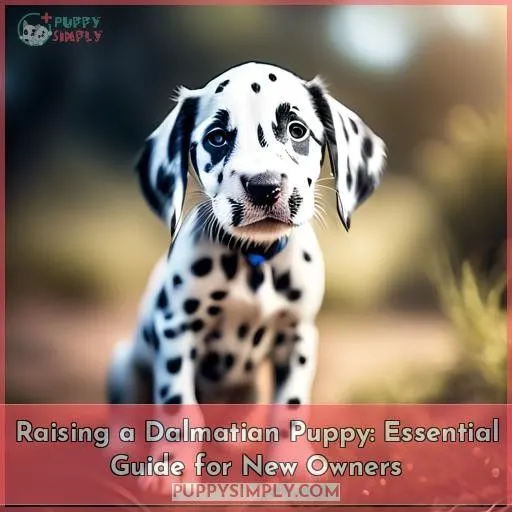This site is supported by our readers. We may earn a commission, at no cost to you, if you purchase through links.

Congrats on your new spotted pal! Raising a Dalmatian puppy takes dedication, but it’s worth it to watch them grow into confident, energetic companions.
Start by socializing your pup early – visit puppy classes, invite friends over, and gradually expose them to new sights and sounds.
Feed a balanced diet and keep them active to avoid common health issues like bloat.
With patience and positive reinforcement, you’ll build a bond that lasts a lifetime. Want to delve deeper into the essentials of Dalmatian puppy care? Keep reading to discover essential tips for this high-energy breed.
Table Of Contents
- Key Takeaways
- Importance of Socializing Your Dalmatian Puppy
- Introducing Your Puppy to New Environments
- Feeding Your Dalmatian Puppy
- Health and Activity Considerations
- Recognizing and Treating Common Health Issues
- Frequently Asked Questions (FAQs)
- What is the best age to start socializing a Dalmatian puppy?
- How often should a Dalmatian puppy be fed?
- What are the recommended feeding amounts for a Dalmatian puppy?
- How can I ensure my Dalmatian puppy gets proper socialization?
- What are the common mistakes to avoid when socializing a Dalmatian puppy?
- Conclusion
Key Takeaways
- Early socialization is crucial for Dalmatian puppies, ideally between 8 and 16 weeks old.
- A balanced diet and regular exercise are essential for maintaining a healthy Dalmatian puppy.
- Positive reinforcement and crate training can help establish a strong bond between the owner and the puppy.
- Regular veterinary check-ups and monitoring are important for detecting and treating potential health issues in Dalmatian puppies.
Importance of Socializing Your Dalmatian Puppy
Socializing your Dalmatian puppy from an early age is essential. Expose them to positive experiences at a gradual pace, involving family and friends, and consider enrolling them in puppy socialization classes.
Early Socialization Benefits
Socializing your Dalmatian puppy is vital for their overall well-being and development. It’s imperative to expose them to different people, animals, and situations as early as possible, ideally between 8 and 16 weeks old. This process helps them become less fearful and more confident as they grow up. Here are some ways to socialize your Dalmatian puppy:
- Puppy classes or dog parks: Enroll your puppy in puppy classes or take them to dog parks where they can meet other puppies and dogs. These environments provide structured socialization and help your puppy learn how to interact with others.
- Playdates: Arrange playdates with other dog owners or attend puppy playtime classes. This allows your puppy to have positive experiences with other dogs and learn appropriate social behaviors.
- Training classes: Enroll your puppy in obedience training classes. These classes not only teach your puppy basic obedience but also provide opportunities for them to interact with other puppies in a controlled environment.
- Meeting new people: Introduce your puppy to a variety of people, including children, neighbors, and friends. This helps them get used to different types of people and learn how to respond appropriately.
- Handling different situations: Gradually expose your puppy to different environments and situations, such as car rides, trips to the vet, and visits to the park. This helps them become more comfortable and confident in various settings.
Positive Experiences
Introduce your Dalmatian puppy to a variety of positive experiences to foster a well-rounded, confident, and happy dog. Start with puppy parks, where they can interact with other dogs.
Leash training and crate training are essential for a smooth adjustment into their new environment. Use positive reinforcement to encourage good behavior and keep health records up-to-date.
Introduce them to dry dog kibble, puzzle toys, and fruits like watermelon and bananas for a balanced diet.
Pace and Comfort
When raising a Dalmatian puppy, it’s vital to maintain a steady pace and guarantee their well-being. Here are some tips to help you with puppy training:
- Crate training: Introduce your puppy to their crate gradually, making it a comfortable and secure space.
- Clicker training: Use positive reinforcement techniques like clicker training to reward good behavior.
- Leash training: Start leash training early to help your puppy learn limits and stay protected.
- Housebreaking: Establish a routine for potty breaks to help your puppy learn where to go.
- Feeding schedule: Stick to a regular feeding schedule, offering wet dog food in the morning and large breed puppy biscuits at dinner.
- Health considerations: Keep an eye on your puppy’s health, monitoring for symptoms like swelling on the head and adjusting their diet with fresh veggies and horse carrots.
Involving Family and Friends
Involving your family and friends in your Dalmatian puppy’s upbringing is essential for their social development. By forging bonds with different people, your puppy will learn to trust and feel at ease around various individuals.
This can be as straightforward as having family members interact with the puppy or inviting friends over for a social gathering. The more positive interactions your puppy has with a diverse range of people, the stronger their social skills will become.
Puppy Socialization Classes
After getting your family and friends on board, it’s time to leap into puppy socialization classes. These aren’t just any old gatherings; they’re your pup’s intro to the big, wide world.
- Puppy playdates teach them the art of making furry friends.
- Training treats turn obedience commands into a game.
- Crate training becomes a cozy retreat, not a penalty box.
- Leash etiquette makes sure walks are a breeze, not a tug-of-war.
Introducing Your Puppy to New Environments
Introduce your dalmatian puppy to new people and pups at a gentle pace. Let them approach your pup on their terms to avoid overwhelming them.
Meeting Other Dogs
Meeting other dogs is a significant part of your Dalmatian puppy’s socialization process. It’s important to introduce your puppy to new environments and other dogs in a controlled and safe manner. Here’s how you can do it:
- Leash Etiquette: When walking your puppy, keep a safe distance from other dogs. Avoid letting them meet face-to-face on leashes, as this can lead to reactivity and aggression.
- Play Dates: Arrange play dates with other dogs in a controlled environment, like a fenced yard or a dog park. This will allow your puppy to interact with other dogs without the tension of a leash.
- Dog Parks: Once your puppy is old enough, consider taking them to dog parks. These are great places for puppies to socialize and learn how to interact with other dogs.
- Training: Enroll your puppy in puppy socialization classes. These classes provide a controlled environment for your puppy to meet other dogs and learn basic commands and good manners.
| Table: | Environment | Advantages | Disadvantages |
|---|---|---|---|
| Leash Walks | Opportunity for controlled exposure to other dogs | Risk of leash reactivity and aggression | |
| Play Dates | One-on-one interaction with other dogs | Limited socialization opportunities | |
| Dog Parks | Variety of dogs and socialization experiences | Potential for overstimulation | |
| Puppy Classes | Structured learning environment | May not mimic real-world experiences |
Interacting With People
As your Dalmatian puppy grows, it’s essential to familiarize them with new environments and people. Begin with play dates at puppy parks, where they can interact with other dogs. Gradually expose them to interactions with strangers, starting with known faces and progressing to unfamiliar individuals.
Public transportation can be a difficult experience, so practice during off-peak hours when the puppy is well-rested.
Lastly, veterinary appointments are necessary, so accustom them to the car and veterinarian’s office at an early stage.
Handling Different Situations
- Emergencies: Be prepared for unexpected situations by keeping a first aid kit handy.
- Separation Anxiety: Gradually accustom your puppy to being alone by leaving them for short periods and rewarding them when you return.
- Crate Training: Use a crate as a safe space for your puppy, gradually increasing the time they spend there.
- Housebreaking Accidents: Clean up accidents promptly and use positive reinforcement to encourage good habits.
Avoiding Overwhelm
Introducing your Dalmatian puppy to new environments without causing a tailspin of overwhelm is a fine art. Think of it as a dance, where patience leads. Start with basic commands as your foundation, then gracefully move into leash training. Keep the rhythm with crate training and exercise routines. It’s not a sprint; it’s a marathon of joyful discoveries.
| Training Techniques | Crate Training | Exercise Routines |
|---|---|---|
| Basic Commands | Safe Haven | Daily Adventures |
| Leash Training | Quiet Time | Energy Burn |
| Patience & Consistency | Security Zone | Fun & Games |
Feeding Your Dalmatian Puppy
Feeding your Dalmatian pup right is key to their health. Follow this easy schedule and food tips to keep your spotted pal fueled and fit.
Feeding Schedule
Feeding your Dalmatian puppy is a vital aspect of their development and well-being. To guarantee proper growth and health, it’s essential to establish a consistent feeding schedule and pay attention to the type and quantity of food you provide. Here are some guidelines to follow:
- Feeding Frequency: Dalmatian puppies should be fed three times a day, with their tummy line tucked up, indicating they’re ready for their next meal.
- Food Textures: Offer a combination of moist and dry food to provide variety and promote dental health.
- Moist vs Dry Food: Moist food can help your puppy stay hydrated and may be more appropriate for older dogs with dental issues. Dry food, on the other hand, can help with dental hygiene and is more convenient for storage and transport.
- Food Sensitivities: Be aware of your puppy’s potential food allergies or sensitivities, and consult with your veterinarian if you suspect any issues.
- Mealtime Routine: Stick to a regular feeding schedule to help your puppy establish a routine and avoid overeating.
Types of Food
As a new Dalmatian owner, it’s essential to grasp the significance of feeding your puppy a balanced and species-appropriate diet. While there are many choices available, it’s necessary to take into account the specific requirements of your Dalmatian. Here’s a breakdown of the types of food that are recommended for Dalmatians:
- Chicken and Turkey: These are popular protein sources for most Dalmatians. They’re low in purines, which can be problematic for some Dalmatians, and they offer a balanced mix of essential amino acids for growth and development.
- Raw Diets: Some Dalmatian owners prefer raw diets, which consist of raw meats, bones, vegetables, fruits, herbs, and dairy products. These diets are species-appropriate and can help prevent a range of health issues, including obesity, joint, dental, and digestive problems, and common allergy symptoms.
- Low-Purine Diets: Dalmatians are prone to urate urolithiasis, a condition leading to urinary stones. Therefore, it’s essential to choose foods with lower purine content to reduce the risk of urate crystals or stones in the urinary tract.
- Specialized Diets: For Dalmatians with specific health issues, such as urinary problems or allergies, there are commercial low-purine foods available without prescription. Royal Canin makes a food specifically for Dalmatians based on egg protein, which is very low in purines.
- Commercial Diets: Brands like Blue Buffalo Life Protection Formula, Merrick Classic, Wellness Complete Health, and Canidae All Life Stages offer low-purine options that cater to the unique health needs of Dalmatians.
Feeding Amounts
Feeding Your Dalmatian Puppy: A Guide to Portion Sizes and Weight Monitoring
Feeding your Dalmatian puppy is vital for their growth and development. To guarantee your puppy develops into a healthy adult, it’s imperative to adhere to a balanced diet that provides the necessary nutrients. Here are some guidelines to assist you in determining the appropriate feeding amounts for your Dalmatian puppy:
Weight Monitoring: Regularly track your puppy’s weight. This will help you safeguard against overfeeding or underfeeding. A Dalmatian puppy should weigh between 6.5 and 9.4 kg at 3 months and between 11.9 and 17.4 kg at 6 months.
Portion Sizes: Based on their age, weight, and activity level, your Dalmatian puppy should receive 2.38 to 3.25 cups of food per day, providing between 940 and 1293 kcal of nutrients.
Feeding Frequency: Puppies should be fed three times daily, while adult Dalmatians should be fed twice daily.
High-Quality Food: Select a superior quality dog food that’s specifically tailored for puppies. This will help guarantee your puppy receives the ideal balance of nutrients for their growth and development.
Additional Feeding Tips
To keep your Dalmatian puppy healthy and satisfied, consider these additional feeding tips:
Split kibble with wet food to add variety and make meals more appealing.
Introduce fresh vegetables and fruit to their diet without adding fat.
Puzzle toys can help tire them out and make them feel fuller.
Health and Activity Considerations
As a new Dalmatian puppy owner, keeping a vigilant eye on your pup’s health and activity level is paramount. Ensure to deworm your puppy periodically, monitor their food consumption, and promote ample physical exertion to avert issues like bloat.
Importance of Worming
As a responsible Dalmatian owner, you’ll want to prioritize worming procedures to keep your furry friend healthy. Worming frequency should be in line with your vet’s recommendations, typically every 3-6 months for puppies.
Worming medications come in various forms, such as tablets, liquids, or topical treatments. Keep an eye out for signs of worms, like coughing, weight loss, or anemia.
Worming benefits include preventing intestinal parasites and reducing the risk of transmission to humans.
Monitoring Food Intake
Monitoring your Dalmatian’s food intake is essential for their health and well-being. Establish a feeding frequency that suits their nutritional requirements, ensuring portion control and a mealtime routine.
Remember to mix things up with food variety to keep them interested and healthy. Note, overseeing food intake isn’t just about preventing overfeeding but also about ensuring your pup gets the right balance of nutrients for their growth and development.
Encouraging Physical Activity
Encouraging Physical Activity for Your Dalmatian Puppy
Your Dalmatian puppy is full of energy and needs regular exercise to stay happy and healthy. Here are four ways to keep your pup active:
- Outdoor Games: Dalmatians love to run and play. Set up a game of fetch, frisbee, or tug of war in the backyard to exhaust them.
- Indoor Activities: When the weather is bad, or your pup needs a break, engage them in indoor activities like hide-and-seek with treats, or a puzzle toy that dispenses kibble.
- Playtime Motivation: Use toys that encourage your puppy to move, like a ball launcher or a toy that dispenses treats when rolled.
- Socialization Opportunities: Interact with other dogs at the dog park or during puppy playdates. This not only provides physical activity but also mental stimulation and socialization.
Recognizing Symptoms of Bloat
As a Dalmatian puppy owner, it’s imperative to be cognizant of the signs of bloat, a life-threatening condition that can afflict your furry companion. Bloat, also known as gastric dilation volvulus (GDV), occurs when a dog’s stomach fills with gas and food, causing abdominal pain and impairing blood flow to the stomach and other organs. Symptoms of bloat include agitation, excessive panting, salivating, and retching without vomiting. In severe cases, the stomach may twist, leading to a rapid pulse, labored breathing, and collapse.
Bloat is most prevalent in large breeds with deep chests, such as Great Danes, Doberman pinschers, and Saint Bernards. However, any dog can develop bloat, and it can occur without warning. To forestall bloat, follow these guidelines:
- Feed your puppy multiple small meals throughout the day instead of one or two large meals.
- Allow at least one hour after a meal or drinking a large amount of water before engaging in exercise or playtime.
- Use a slow feeding bowl to prevent your puppy from consuming food too swiftly.
- Discuss preventative surgery with your veterinarian for breeds with a higher risk of bloat, such as Dalmatians.
If you suspect your puppy has bloat, seek veterinary attention promptly. Treatment may include inserting a stomach tube, administering intravenous fluids, and performing surgery to untwist the stomach and remove damaged tissue. In some cases, a gastropexy procedure may be performed to attach the stomach in place, reducing the risk of future bloat.
Recognizing and Treating Common Health Issues
As a Dalmatian puppy owner, it’s important to be on the lookout for any concerning health issues. Keep an eye out for symptoms like unexplained swelling on your pup’s head, and don’t hesitate to get it checked out – your vet can help determine the cause and provide the right treatment.
Identifying Symptoms
Recognizing Symptoms:
- Swelling on top of the head
- Not sore to the touch
- No reaction when touched
- Developed quickly
- Cartoon-like appearance
Monitoring and observation are essential in relation to your Dalmatian’s health. Be alert for any signs of swelling, especially on the head, which could indicate a head injury or a more serious condition like a seroma or hematoma. These conditions may require aspiration to drain the affected area and may be treated with anti-inflammatory medication or x-rays to rule out fractures. The prognosis for most seromas is good, as they often resolve over time, while fractures will heal unaided. However, displaced fractures may require watchful waiting.
Understanding Possible Causes
Understanding Possible Causes (Recognizing and Treating Common Health Issues)
As a Dalmatian owner, it’s paramount to be aware of the potential health issues your furry friend might encounter. Some of the common health concerns in Dalmatians include hypothyroidism, iris sphincter dysplasia, seizures, deafness, bladder stones, hip dysplasia, and copper-associated liver disease. Let’s explore these possible causes in more detail:
- Hypothyroidism: This condition occurs when the thyroid gland fails to produce a sufficient amount of thyroid hormones, resulting in an imbalance in your dog’s metabolism. Symptoms may include weight gain, lethargy, coldness, recurring skin and ear infections, poor coat quality, and increased skin pigmentation. Treatment involves regular thyroid hormone replacement, often administered orally.
- Iris Sphincter Dysplasia: This eye condition affects Dalmatians, particularly those with liver-spotted coats. It occurs when the iris sphincter, the muscle that causes the pupils to dilate and constrict, doesn’t function correctly. This makes your dog more sensitive to sunlight and potentially susceptible to other eye conditions.
- Seizures: Seizures are caused by a sudden surge of electrical activity in the brain, leading to trembling and loss of consciousness. Different seizures can have varying signs, such as collapse, stiffness, and paddling limbs. Causes include cancer, head trauma, and liver or kidney disease. Treatment depends on the underlying cause and severity of the seizures.
- Deafness: Dalmatians can be born deaf or develop hearing loss over time. Signs include a lack of responsiveness to their name and not being startled by sudden noises.
- Bladder Stones: These are mineral deposits that can accumulate over time, leading to difficulty urinating, discolored urination, and licking around the urinary opening. Treatment may involve antibiotics or a therapeutic diet.
- Hip Dysplasia: This condition affects large-breed dogs, including Dalmatians. It occurs when the hip joint doesn’t develop properly, resulting in dysfunction and pain. In later years, it may cause arthritis, muscle atrophy, and impaired mobility. Treatment options include surgery and medical management, depending on the severity of the case.
- Copper-Associated Liver Disease: This condition occurs when a Dalmatian has accumulated excessive copper in their liver. Symptoms can range from apparent health to jaundice.
To ensure your Dalmatian’s health and well-being, it’s critical to monitor for these symptoms and seek veterinary care when necessary. Regular check-ups and preventive measures, such as proper nutrition and exercise, can help maintain your dog’s health and happiness.
Treatment Options
As a conscientious pet owner, you aim to guarantee that your Dalmatian puppy receives the most ideal care. In terms of addressing prevalent health concerns, there are various choices to contemplate. Here are four treatment options that may be advised by your veterinarian:
Aspiration: In some instances, your veterinarian may recommend aspiration to evacuate seroma or hematoma. This process involves utilizing a needle to extract the accumulated fluid, providing relief and mitigating the risk of complications.
Observation and monitoring: For specific conditions, such as displaced fractures, your veterinarian may recommend vigilant observation. This entails closely monitoring your puppy’s condition and permitting the body to heal intrinsically, without interference.
Anti-inflammatory medication: Nonsteroidal anti-inflammatory drugs (NSAIDs) can be employed to manage pain and inflammation in your Dalmatian. These medications function by reducing the production or function of prostaglandins, which are involved in inflammation. However, NSAIDs ought to be employed cautiously, as they can induce side effects and should only be prescribed by a veterinarian.
X-rays: In some cases, your veterinarian may recommend X-rays to eliminate fractures or other underlying conditions. This can assist in determining the appropriate treatment plan for your puppy.
Monitoring and Prognosis
Monitoring and prognosis are vital aspects of your Dalmatian’s health. Keeping a watchful eye on your dog’s well-being can help you catch potential issues early and provide timely treatment. Here’s a table to help you understand the common health issues and their prognosis:
| Health Issue | Symptoms | Causes | Prognosis |
|---|---|---|---|
| Seroma | Large swelling on top of the head | Head injury from fight with brother | Most seromas resorb over time |
| Hematoma | Large swelling on top of the head | Collection of blood | Fractures will heal unaided |
| Bloat | Symptoms not specified | Overfeeding, especially in large breeds | Displaced fractures may require watchful waiting |
Regular veterinary check-ups and monitoring at home can help you keep your Dalmatian healthy and happy. Remember, early detection is key to ensuring the best possible outcome for your furry friend.
Frequently Asked Questions (FAQs)
What is the best age to start socializing a Dalmatian puppy?
Like a flash of lightning, the best time to socialize your Dalmatian pup is as early as possible – from 8 to 12 weeks old. It’s a critical window to build their confidence and make them the belle of the ball.
How often should a Dalmatian puppy be fed?
Dalmatian pups need three square meals a day – wet kibble in the morn, dry kibble at lunch and dinner. Just keep an eye on their tum, make sure they’re eatin’ up a storm! Need more details? Gimme a shout!
What are the recommended feeding amounts for a Dalmatian puppy?
Start small, pup – just half a tin of wet food in the morn’. As your appetite grows, work up to a full tin. At dinner and night, 200g of large breed puppy kibble’s the ticket. You’ll be barking up the right tree in no time!
How can I ensure my Dalmatian puppy gets proper socialization?
Get that pup out there, pal! Socialize ’em with lots of new sights, sounds, and pals. Puppy classes, park playdates – heck, introduce ’em to the whole dang neighborhood! Keep ’em happy, healthy, and ready to roll with the pack.
What are the common mistakes to avoid when socializing a Dalmatian puppy?
Puppy socialization is a tightrope walk – avoid isolating them in their shell and overdoing the social whirl. A balanced approach, like a spotted coat, keeps them bounding with confidence and companionship.
Conclusion
Raising a Dalmatian puppy is a dynamic journey – one filled with playful exploration, unwavering dedication, and lasting bonds. Socialize your spotted pal early to nurture their energetic spirit.
Provide a balanced diet and keep them active. With patience and positive reinforcement, you’ll witness your Dalmatian puppy blossom into a confident, beloved companion.
Embrace the paw-some adventure of owning a Dalmatian, and cherish every spot-filled moment along the way.











